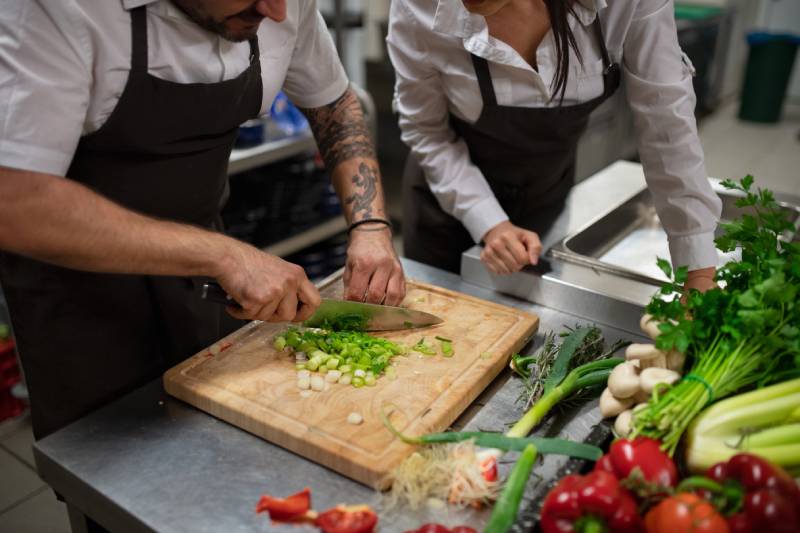
Staffing costs are usually amongst the higher end of the scale when it comes to the costs of running a venue. General wisdom dictates that staffing costs should hit between the 20% to 30% mark in your gross revenue, however, once your venue begins to veer further away from a quick service restaurant model, and into the realms of fine dining, your staffing costs will also likely rise since there’ll be a need for more staff and a higher level of service.
This can be a tricky thing to master because there’s really no sure-fire way to go about managing staffing costs in hospitality because (thankfully) variety is the spice of life and each restaurant, bar or cafe is different. And it’s because of these differences that each place will require a different approach to managing their staffing costs.
As a first step, you can start by keeping track of staffing via your restaurant POS system, but after that point, it’s all going to depend on the unique needs of your restaurant.
That said, here are a few essential tips and tricks for calculating and managing restaurant staffing costs:
- Group your restaurant staffing costs for greater clarity
- Use a simple staffing costs formula
- Move beyond asking ‘what percentage of sales should staff costs be today?’
- Save on restaurant staff costs with training and thoughtful scheduling
- Average staffing costs by venue type
Need some more guidance with your staffing issues?
Our guide to hospitality recruitment covers every step of building your dream team. From recruitment, to training, to retaining your staff, we've got you covered.
Group your restaurant staffing costs for greater clarity
Dividing your team into groups is a good way to see which positions cost you the most.
- Front of house (FOH) team – assign your FOH team (waitstaff, bartenders etc.) to one group
- Kitchen staff such as cooks & dishwashers would fall into another group
- Management team (maître d, head chef) would be in a separate group
Once you have all of your staff divvied up, you can compare the staffing costs of each team.
This is a good opportunity to see which combinations of staff work best to ensure you get the most cost-efficient roster whilst sacrificing none of your customer service levels.
Use a simple staffing costs formula
If you’re anything like me, the idea of delving into the world of figures & formulas is enough to send you into a downward, cross-eyed spiral the likes of which offer little hope of return.
I’m here to tell you that this doesn’t have to be the case.
It’s as simple as adding all of your staff costs to your COGS to show you what’s known as your prime cost.
That’s it. Pretty simple, right?
Try and keep this figure to 60% or less than your total revenue and that’s the bulk of your expenses covered.
Move beyond asking, ‘what percentage of sales should staff costs be today?’
Calculating staff costs as a percentage is no doubt very useful, but measuring staff productivity based solely on a percentage alone is a perilous thing indeed, and it doesn’t even begin to give you the full picture necessary for identifying areas that could use a little improvement.
For example, let’s say it’s your policy to keep your staff costs to 20% of your gross revenue or less, and one day it hits 25%. You’re going to look at this and begin to sweat a little as your dream of retiring down the coast by the age of 40 starts to slowly slip from your grasp.
It’s around this time that I recommend reframing how you analyse your data, if only to limit the occasional panic attack on the days or weeks that costs run a touch higher than normal.
Always consider the differences in trade, the differences in actual staff costs for a shift and the differences in shifts themselves. A mediocre midweek lunch service isn’t the same as pumping weekend dinner service. Neither is a shift staffed by your top-dollar ‘A Team’ compared to one staffed by the reserves.
Trade ebbs and flows but it does usually show a more consistent level when you take a step back and look at it over a longer period of time. I’ve always liked to break periods down month-by-month to give me an accurate idea of how a business is fairing.
Once you can see the patterns emerging, you can identify the bad ones and make a much more informed (not to mention much less knee-jerk) decision on how best to rectify it.
Save on restaurant staff costs with training and thoughtful scheduling
You can monitor (in a totally, non-big brotherly way) your team to see not only when they clock in or out, but also if their shifts wander into overtime territory. This can be integrated into your POS and it gives you the right data and tools to make the most cost-effective changes.
If you can see that a certain higher-paid member of your team is constantly working longer hours, or shifts where they qualify for a higher pay rate such as weekends or public holidays, you can make some slight adjustments to your roster to ensure that they can end their shifts before going into overtime by bringing a junior replacement in, or limiting the amount of weekends or public holidays they work.
Training your team properly ensures that they’ll be operating the way you want them to operate and it’ll be in a more productive manner. They’ll also be less likely to jump ship as your investment in their development should make them feel more valued and show them a real path for professional growth.
Average staffing costs by venue type
Okay, now that we’ve covered the basics, it’s time to look into some staff costs based on venue types so that you can gauge a ballpark percentage of what your staff costs should be hovering around:
- Cafe – Cafes tend to float around the lower end of the staff costs spectrum between 20% to 30%. This is due to a few reasons, namely the tendency for cafe staff to be more casual (meaning paid by the hour) rather than salaried. There’s also cheaper ingredients than those in a fully-fledged restaurant, and usually less-trained staff in the kitchen. Finally, there’s more owner/operators in the cafe industry than elsewhere in hospitality which cuts down on having to pay somebody else to do a job that you already do.
- Bar – Bars have quite a wide range and can get as low as cafes at 20%, but also have the potential to rise to over 30%; it all depends on the type of bar we’re talking about. A good dive bar will sell cheap alcohol and perhaps a limited selection of cheap to produce food to line the customer’s stomachs. Their inventory will have high profit margins which, in turn, will push the staff cost percentage down. Whereas a good wine bar or cocktail place will offer more expensive alcohols and food which also require a more-skilled team that attract a higher wage, raising the staff cost percentage with each bottle of Domaine de la Romanee-Conti ordered for the cellar.
- Restaurant – Restaurants, like bars, come in varying levels and can creep upwards of 40%.
- A quick service restaurant (like a burger joint or a sandwich shop) can keep their costs low because their range of products offered can be limited, therefore they can hire cheaper, untrained staff and teach them only what’s necessary for the shift to run smoothly.
- A full-service restaurant (what normal people would simply call ‘a restaurant’) widens their offerings to full menus, a larger drinks list and table service. A few of the jobs here require a trained set of hands to execute and those hands will come open in expectation of a higher wage. The ingredients will usually be higher costing too, pushing that staff cost percentage upwards still.
- Finally, a fine-dining restaurant (or ‘fancy restaurant’ to the average human) spares no expense and that extends to the staff. These are the types of places where the chef has more followers than a Kardashian, the bartender keeps using words that you don’t recognise, and the waiting list for a table is longer than that of a Playstation 5. These places strive to be the best-of-the-best and being the best is a pricey endeavour. High inventory costs paired with high wages can only equal one thing: a high staff cost percentage.
Need help choosing your venue's tech?
Our restaurant POS system can help you track employee performance and costs, identify areas that need improvement, and more. Chat to one of our point of sale experts about how Lightspeed can improve your venue today!

News you care about. Tips you can use.
Everything your business needs to grow, delivered straight to your inbox.


